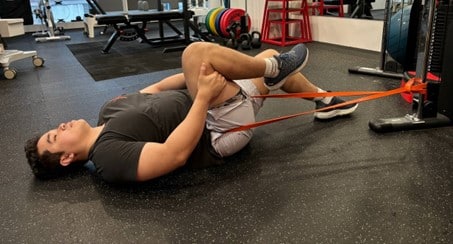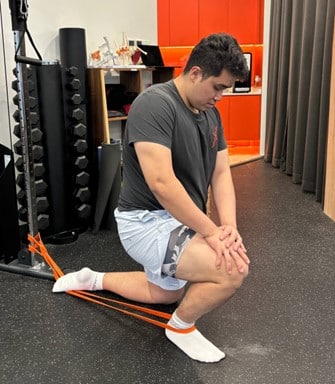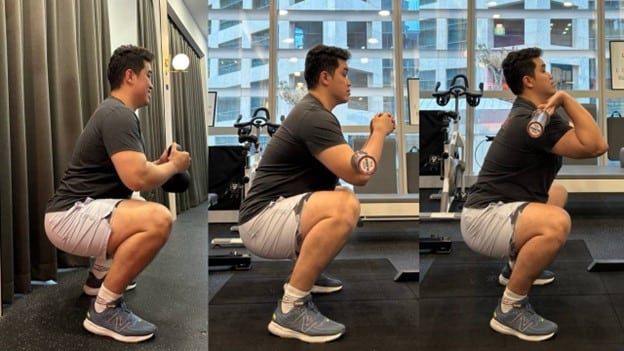“Having a butt wink in a squat is bad!”
This statement is one that we commonly hear in the fitness industry and when you look it up on the internet – it is touted as a common squat error that can lead to serious injuries. The “butt wink” can be observed when the pelvis is seen tucking underneath at the bottom of the squat. This can create some degree of lower back rounding at the bottom of the squat, which is why it has been deemed dangerous.

However, is the internet right? Should the butt wink be something we have to avoid at all costs? Unfortunately, with most uncertainties in life, the dreaded truth to this question is that it depends. To answer this question well, it is important first to understand why it happens and how we can optimise this pattern.
The butt wink is actually a natural coupled motion between the pelvis and lower back during squats. Whether you are performing a low bar back squat, high bar back squat, front squat, or any other squat variation, these movements typically require around 110 degrees of hip flexion. If the hip cannot achieve this level of flexion, butt wink occurs as a mechanism to gain more depth. As you squat down, you eventually reach a point where your femur (thigh bone) presses against your pelvis, limiting your hip movement. To achieve greater depth and sit comfortably at the bottom of the squat, your pelvis will tilt backwards in search of more “hip flexion.”
The extent and onset of butt wink vary among individuals due to several factors and it is important to recognise that some degree of butt wink is physiologically normal and unavoidable.
The primary concern with butt wink is the associated lumbar flexion, as lumbar flexion under load is considered unsafe for the lower back. Losing lumbar spine extension under load increases the shear force on the lower back, and loaded flexion is often linked to disc herniations. Funnily enough, lifters fearful of the butt wink would often attempt to overcompensate the butt wink by maintaining excessive lumbar lordosis which could counter-intuitively strain their lower backs as well. Ultimately, it’s crucial to remember that the neutral positions of both the pelvis and lumbar spine encompass a range, and having some flexibility within this range is normal and even beneficial.
Potential Causes & Fixes
If you notice butt wink occurring very early in the range of motion or an excessive amount, it’s important to identify if other limitations are causing it.
1. Mobility Restrictions
(a) Glute Tightness
- Tight gluteal muscles can limit the amount our hips can flex, and we may notice that our low back rounds at the bottom to compensate. If the glutes are tight, rolling out on a foam roller or performing a PNF stretch into hip flexion are great ways to alleviate muscle tightness.

(b) Hip Flexion Articular Restriction
- A restriction in the hip capsule can also limit hip flexion and contribute to early butt wink. In this instance, an inferior glide self-mobilization with a band can reduce the restriction. To perform this, attach a resistance band to a stable anchor point and loop the other end around the top of your thigh, near the hip joint while lying down. To execute the glide, bring your knee towards your chest and this position for a few seconds, feeling the stretch in the hip.

(c) Lack of ankle dorsiflexion
- Without adequate ankle dorsiflexion, the amount of forward knee travel in a squat may be limited. To manage this, incorporating a banded ankle mobilisation or performing heel elevated squats may help.

2. Mechanical Alignments/Form
Each person’s body is unique, with differences in bone alignment such as femur length and how the femur fits into the hip socket. These variations affect how we should move and what we can expect from our movements. Each build will have optimal planes and orientations for performance and safety. Although we can’t alter our bone structure, we can improve our control to find the best mechanics for ourselves. Our foot positioning may also play a key role in how we stabilize our pelvis at the bottom of a squat. While some people find a narrow stance with feet facing straight forward comfortable, it can restrict squat depth for many. Slightly angling the toes outward and positioning the feet about shoulder-width apart can place the hip joint in a more comfortable position, minimizing the need for the lower back to compensate.
3. Lack of stability/motor control of the lower back & pelvis
To determine if a lack of stability is a cause, compare a bodyweight squat to a squat with a weight held in front. If stability is an issue, the bodyweight squat will likely produce a butt wink at the bottom, while the front-weighted squat will act as a counterbalance, reducing or eliminating the butt wink. In this situation, it will be good for the athlete to work on front-loaded squat variations to improve their ability to maintain stability and proper alignment of the lumbar spine (lower back) and pelvis during the squat (as shown in Figure 5).

Ultimately, determining if the butt wink is dangerous for an individual is very context dependent and managing it can require a fair amount of experiment to find what works best. As long as we have good physical preparedness for the positions that we are striving towards, there is no reason the butt wink should be demonised or labelled as a negative movement.
Key Takeaways:
- “Butt Wink” is a natural coupled motion between the pelvis and lower back during squats that is normal and unavoidable
- Perceived negatively due to its association with lumbar flexion and potential lower back strains
- Recognizing individual differences in movement and creating sustainable positions in training is key
- Coaches and clinicians should also collaborate with athletes to determine the best course of action, using strategies like introducing counterbalances to improve stability, improving hip & ankle mobility or optimising foot positioning in squats.

